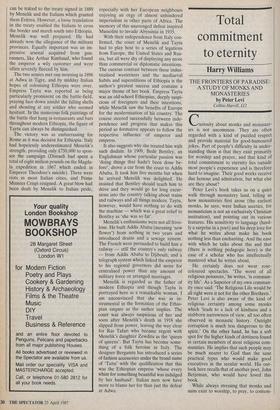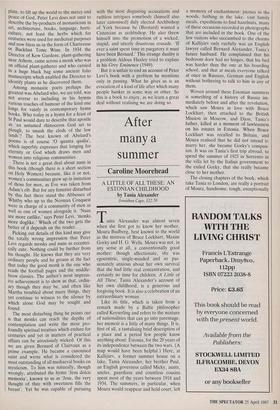Total commitment to eternity
Harry Williams
THE FRONTIERS OF PARADISE: A STUDY OF MONKS AND MONASTERIES by Peter Levi
Collins Harvill, £12
Curiosity about monks and monaster- ies is not uncommon. They are often regarded with a kind of puzzled respect and provide material for good-humoured jokes. Part of people's difficulty in under- standing them is that they exist primarily for worship and prayer, and that kind of total commitment to eternity lies outside most people's experience and is therefore hard to imagine. Their good works receive due honour and admiration, but what else are they about?
Peter Levi's book takes us on a quiet walk through monastery land, telling us how monasteries first arose (the earliest monks, he says, were Indian ascetics, for monasticism is not an exclusively Christian institution), and pointing out its various features. His sensitivity to language (hard- ly a surprise in a poet) and his deep love for what he writes about make his book nothing less than enchanting. And the ease with which he talks about this and that (there is nothing pedagogic here) is the ease of a scholar who has intellectually mastered what he writes about.
He certainly does not wear rose- coloured spectacles. 'The worst of all religious penances,' he writes, 'is commun- ity life'. As a Superior of my own commun- ity once said: 'The Religious Life would be all right were it not for the other Brethren.' Peter Levi is also aware of the kind of religious certainty among some monks which 'leads to a lack of kindness and a stubborn narrowness of view, all too often observed in monastic history. Outright corruption is much less dangerous to the spirit.' On the other hand, he has a soft spot for the higher kinds of dottiness found in certain members of most religious com- munities. He implies that such people may be much nearer to God than the sane practical types who would make good executives in the secular world. His out- look here recalls that of another poet, John Betjeman, who would have loved this book.
While always stressing that monks and nuns exist to worship, to pray, to contem- plate, to lift up the world to the mercy and peace of God, Peter Levi does not omit to describe the by-products of monasticism in art, architecture, books, language, horti- culture, not least the herbs which for centuries were used for medicinal purposes and now bless us in the form of Chartreuse or Buckfast Tonic Wine. In 1934 the Director of Kew Gardens, plant-gathering near Athens, came across a monk who was an official plant-gatherer and who carried in a huge black bag some ancient folio manuscripts which enabled the Director to identify plants as he discovered them.
Among monastic poets perhaps the greatest was Abelard who, we are told, was not. averse to including in his hymns various touches of humour of the kind one longs for vainly in contemporary hymn books. Who today in a hymn for a feast of St Paul would dare to describe that apostle as 'an untamed rhinoceros God set to plough, to smash the clods of the low lands'? The best known of Abelard's poems is of course '0 quanta qualia', which superbly expresses that longing for eternity or God which draws men and women into religious communities.
There is not a great deal about nuns in this book (though there is a short section on Holy Women) because, like it or not, women's communities grew up in imitation of those for men, as Eve was taken from Adam's rib. But for any feminist disturbed by this fact there stand the Abbesses of Whitby who up to the Norman Conquest were in charge of a community of men as well as one of women alongside it. 'Nuns are more catlike,' says Peter Levi, 'monks more doglike.' Which of the two gets the better of it depends on the reader. Picking out details of this kind may give the totally wrong impression that Peter Levi regards monks and nuns as eccentri- cally cute. Nothing could be further from his thought. He knows that they are very ordinary people and he groans at the fact that today the good monk is the one who reads the football pages and the middle- brow classics. The author's most impress- ive achievement is to show us that, ordin- ary though they may be, and often like Martha troubled about many things, they yet continue to witness to the silence by which alone God may be sought and found.
The most disturbing thing he points out is that monks can reach the depths of contemplation and write the most pro- foundly spiritual treatises which endure for centuries and yet in matters of practical affairs can be atrociously wicked. Of this we are given Bernard of Clairvaux as a prime example. He became a canonised saint and wrote what is considered the most outstanding of all mediaeval books on mysticism. To him was naturally, though wrongly, attributed the hymn lesu dolcis memoria', known to us as `Jesu, the very thought of thee with sweetness fills the breast'. Yet he was capable of pursuing
with the most disgusting accusations and ruthless intrigues somebody (himself also later canonised) duly elected Archbishop of York because he (Bernard) wanted a Cistercian as archbishop. He also threw himself into the promotion of a wicked, stupid, and utterly disastrous crusade. 'If ever a saint spent time in purgatory it must have been Bernard.' This strange duality is a problem Aldous Huxley tried to explain in his Grey Eminence (1949).
But it is unfair to end an account of Peter Levi's book with a problem he mentions only in passing. What he gives us is an evocation of a kind of life after which many people hanker in some way or other. So this is a book to enjoy, as we learn a great deal without realising we are doing so.



































































 Previous page
Previous page